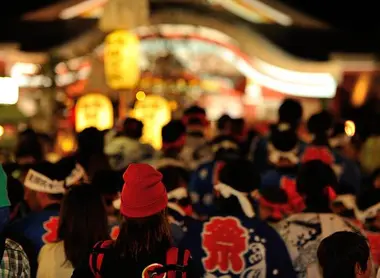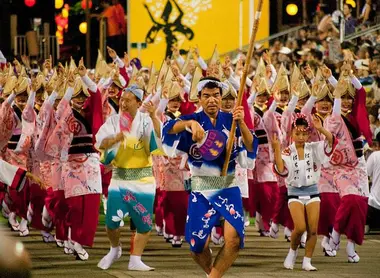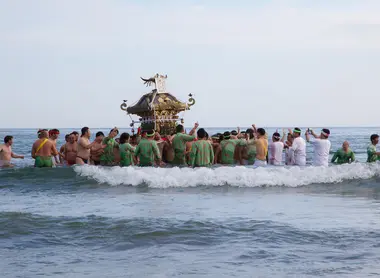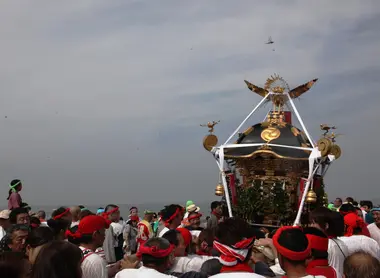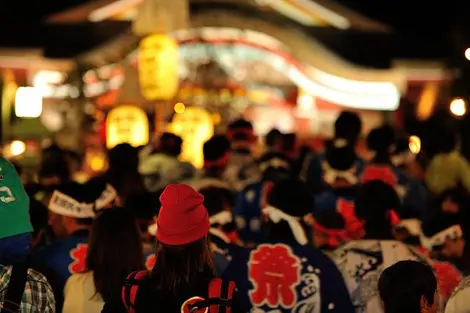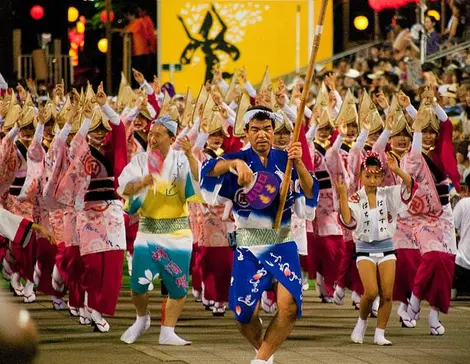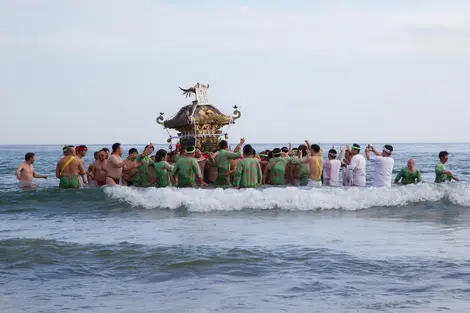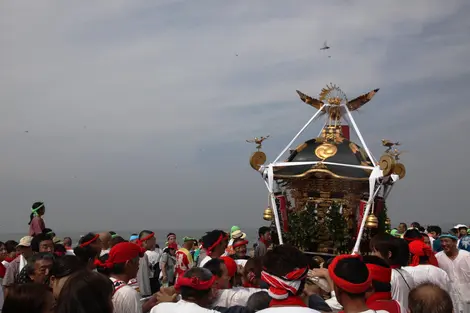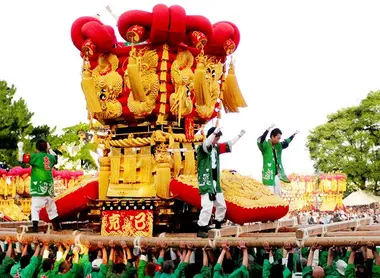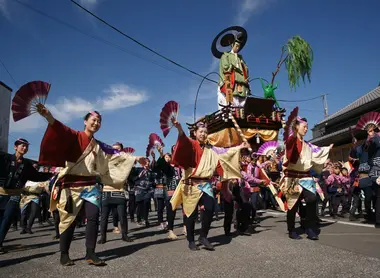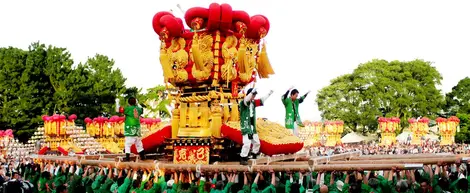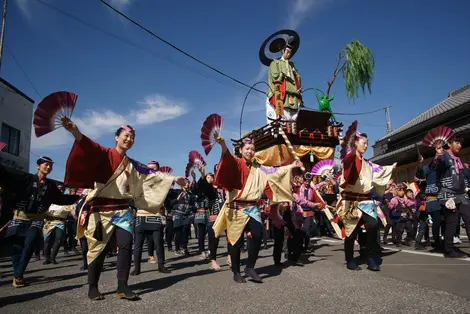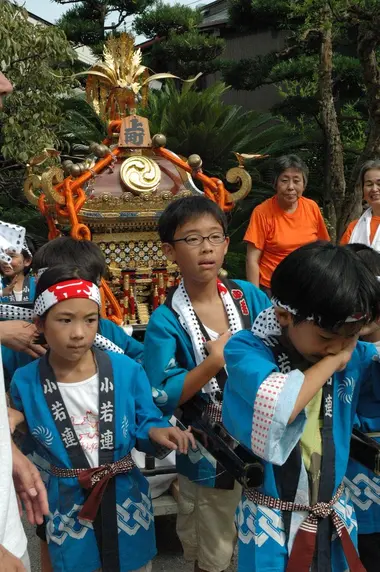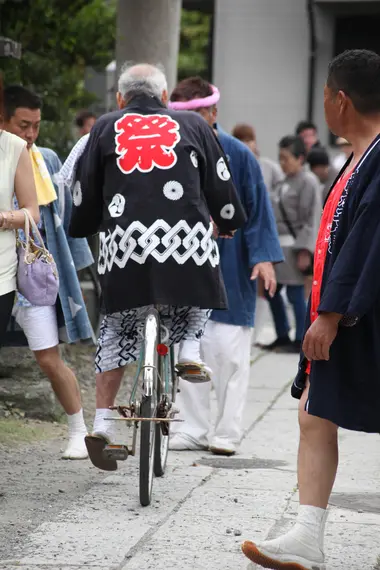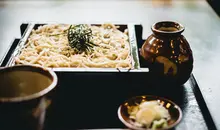Les matsuri, festivals du Japon 日本の祭り
- Publié le : 24/03/2020
- Par : K.C. / I.D.O.
- Youtube
Tout ce dont avez besoin de savoir sur les matsuri
Les matsuri sont à l’origine des cérémonies en l’honneur des divinités shintô. Ils se déroulent tout au long de l’année à travers l’Archipel et revêtent une grande importance. De nos jours, le mot matsuri peut désigner une fête quelconque. Quelques soient l’origine ou le thème de ces festivals, ils constituent pour les voyageurs un plongeon dans les traditions séculaires du Japon et bousculent les stéréotypes : Japonais paradant à demi-nus, hommes et femmes serrés les uns contre les autres pour porter les "palanquins divins", foules en liesse…On est loin de l’image des Nippons réservés et timides…
Qu’est-ce qu’un matsuri ?
Matsuri est le mot japonais qui désigne un festival ou une fête. À l'origine, le mot matsuri est un nom générique employé pour toutes les cérémonies shinto. En japonais, matsuru signifie "honorer", "célébrer les dieux". C’est donc une fête pour remercier ou prier les kami (divinités shintô). Au fil des siècles, le terme matsuri s’est étendu à toutes les fêtes, parfois à des fêtes bouddhistes mais aussi à des événements : "Fête des cerisiers en fleur" "Fête des pruniers" par exemple. Les commerces utilisent aussi ce terme lorsqu’il y a des promotions sur un produit ou des expositions de spécialités régionales : "Hokkaido matsuri" "Okinawa matsuri", etc.
- À lire aussi : Le shintoïsme
Chaque sanctuaire shintô a son festival, une ou parfois deux fois dans l’année. Dans le Japon ancien et rural, ces fêtes avaient lieu en général au printemps pour prier et demander des récoltes abondantes et à l’automne pour remercier les divinités d’avoir donné de bonnes moissons. Ou encore pour prier le dieu de la mer pour la sécurité des pêcheurs et pour des pêches abondantes. Mais le matsuri peut aussi être simplement célébré en l’honneur de la divinité du sanctuaire ou pour commémorer un événement. Il y en a donc tout au long de l'année. Il y en aurait plus de 100 000 par an à travers l’archipel. Certains, devenus très célèbres, attirent désormais des visiteurs du monde entier, tel le Sanja Matsuri à Tokyo ou le Matsuri de Gion, à Kyoto.
Certaines villes ou des quartiers mais aussi de petits villages semblent vivre au rythme de ces fêtes qui demandent une grande mobilisation de la part des participants, une immense énergie et également des moyens financiers importants. Chaque foyer du quartier où se déroule la fête est invité à faire un don. Les préparatifs et répétitions pour les chants, les danses, la musique se font sur plusieurs mois, d’année en année.
Les natsu matsuri, festivals d'été, se distinguent des autres festivals qui ont lieu le reste de l'année par leur plus grande diversité thématique et leur caractère plus "individuel". La fête de l'O-bon, d’origine bouddhiste, est consacrée aux défunts de chaque famille. Tanabata est surtout l’occasion de faire des vœux et les Feux d'artifices, symboles de l’été nippon, n’ont pour but que de divertir la population. Parades diverses et autres spectacles peuvent aussi rassembler les foules. Si vous êtes au Japon l'été, ne manquez pas cette expérience !
- À lire aussi : Top 10 des festivals d'été atypiques
Petit lexique pour vous y retrouver
- Dashi, danjiri , hikiyama, hoko, yama (montagne), yatai : ces termes qui varient selon les régions sont d’immenses chars en bois paradés lors de certains matsuri. Dans l’Antiquité, les Japonais pensaient que les dieux descendaient sur terre lors des matsuri. Pour les accueillir, de petites montagnes ou de petits monticules de terre étaient préparés. Avec le temps, ces petites montagnes sont devenues des véhicules pouvant être déplacés : ce sont les chars de festivals. C’est pourquoi, par exemple, les caractères pour former le mot dashi sont ceux de "montagne" 山 et de "roue" 車.
Plus tard, on a construit des chars très élaborés, délicatement travaillés et décorés, représentant un sanctuaire ou d’autres bâtiments ou objets représentatifs d’une ville ou d’un quartier, ou encore un bateau. Il en existerait environ 5000 répartis dans tout l’archipel. Certains accueillent des karakuri, de grandes poupées représentant généralement des divinités.
"Dokoï, dokoï", "Oïssa, oïssa", "Rassera Rassera", "washoï, washoï" ou encore "Yattosa Yatto Yatto," (liste non exhaustive !) sont divers termes scandés par les porteurs de mikoshi pour se donner du courage et mettre plus d’ambiance. Plus l’épreuve est rude, plus les chants montent en crescendo.
Fundoshi : c’était ce qui servait de sous-vêtement aux hommes avant qu’ils ne portent des slips. Il s’agit d’un long morceau de tissu rectangulaire de coton blanc porté comme un cache-sexe. Certains des porteurs de mikoshi défilent parés d’un fundoshi.
Happi (parfois appelé Hanten) : la veste traditionnelle des porteurs de mikoshi. Elle est ouverte sur le devant et se porte avec une ceinture. Le nom ou le blason du sanctuaire ou du quartier ou de la ville d’où viennent les participants est écrit dans le dos. Elle en général assortie à un short ou à un pantalon de coton et l’ensemble est porté aussi bien par les hommes que par les femmes. Seuls ceux et celles qui portent le happi peuvent parader la châsse portable.
Kami : divinité, dieu de la religion shintô.
Mikoshi : l’élément le plus important des matsuri. Littéralement "palanquin divin", traduit par châsse portable ou temple/sanctuaire portatif, le mikoshi accueille symboliquement "l’esprit du kami" du sanctuaire et est transporté à travers les rues d’un quartier lors des matsuri. Ces sanctuaires portatifs sont extrêmement travaillés et décorés. Certains peuvent peser jusqu’à plus d’une tonne. Les participants les portent sur une épaule à l’aide de poutres (de deux à six, selon la taille). Il existe de plus petits modèles pour enfants.
Mikoshi dago : il s’agit d’une ou de plusieurs bosses dont souffrent certains porteurs de mikoshi, les plus aguerris et les plus fervents ! Malgré la douleur causée par ces inflammations, ils en sont très fiers car cela prouve leur dévouement.
Le déroulement d’un matsuri
La cérémonie sacrée
Un matsuri se déroule en général en deux parties : la partie sacrée où le prêtre ou la prêtresse supérieur.e, gûji sama, invoque la divinité par des incantations et la prie de "descendre" dans la relique du sanctuaire, incarnation physique du kami, que le guji sama placera dans le mikoshi principal qu’il scellera.
Cette cérémonie sacrée se déroule à "huis-clos", à l’intérieur du sanctuaire (honden), là où est déposée la relique du kami. Seuls les membres du sanctuaire et quelques personnalités peuvent assister à ces rituels. L’accès du honden est toujours interdit au public.
Cette cérémonie sacrée très ritualisée est suivie de la procession des mikoshi, festivité populaire empreinte de dynamisme et de gaité où le caractère sacré de la fête est parfois difficile à déceler…
Les porteurs de mikoshi
Les porteurs de mikoshi se divisent en général en trois groupes : les membres du sanctuaire, parfois habillés de blanc, symbole de pureté. Les gens ordinaires, en général les habitant.es du quartier, parfois vêtu.es d'un yukata et… les yakuza. Eh oui, ces membres de la maffia japonaise, d’ordinaire exclus de la société japonaise, font partie intégrante de ces fêtes shintoïstes. Cela s’explique par le fait que ceux qui tiennent les stands lors de la fête étaient des camelots placés sous l’autorité d’un oyabun (parrain/chef). Certains d’entre eux pouvaient porter les mikoshi. Cette corporation s’est développée petit à petit en une maffia et les yakuza ne voulurent pas perdre le rôle qu’ils avaient lors de ces fêtes. Dans les fêtes où ils ont toujours participé, ils sont acceptés de facto. On les reconnaît à leurs tatouages, qu’ils peuvent, le temps de la fête, exhiber fièrement.
Autrefois, seuls les hommes (les femmes, considérées comme impures, étaient exclues bien que dans l’antiquité on vénérait les prêtresses chamanes !) du quartier du sanctuaire avaient le droit de porter les mikoshi ou de tirer les chars. Petit à petit, les femmes ont été acceptées. De nos jours, avec la dépopulation des campagnes, le nombre de jeunes et les divertissements modernes, certains villages ou quartiers manquent de participants et acceptent ou même demandent la participation de personnes de l’extérieur. On peut même parfois voir des étrangers.ères porter le mikoshi. Ce sont en général des résidant.es.
La procession des mikoshi
Guidés par un.e prêtre.sse shintô somptueusement vêtu.e qui agite sa branche de pin sacré (sasaki) pour bénir le quartier, les porteurs de mikoshi défilent à travers les rues au son des instruments traditionnels japonais comme le taiko (tambour japonais) ou la flûte. Parfois ils sont accompagnés de danseurs et danseuses et sont toujours suivis des habitants du quartier ou de toute personne désirant se joindre à la procession.
Le défilé de mikoshi et/ou de chars passe à travers les rues de la ville pour demander aux divinités d’apporter leur bénédiction aux habitants mais aussi pour les divertir et leur montrer leur quartier. C’est pourquoi les "palanquins divins" sont, au cours de la procession, parfois vivement agités de haut en bas et de gauche à droite : on veut amuser les dieux et leur montrer la ferveur de leurs fidèles.
Tout cela sous le "chant" très dynamique des “Oissa ! Oissa !” ou autres "Washoï, washoï". La procession finit devant le sanctuaire, dans un redoublement d’énergie pour secouer les temples portatifs.
Lors des pauses bien méritées, les magasins et restaurants du quartier offrent aux porteurs des mikoshi des boissons et des snacks. A la fin de la fête, chaque porteur.teuse reçoit un petit cadeau : des fruits, des gâteaux…
Un air de fête foraine avec la street food japonaise
Le sanctuaire dont c'est le matsuri se retrouve entouré de stands de jeux et de nourriture, les Yatai. Les mets les plus populaires sont les takoyaki (boulettes de poulpe), les kara-age (poulet frit), les yakisoba (nouilles sautées), les yakitori et les kakigôri (glaces pilées au sirop) et le taiyaki (gaufres fourrées d'une garniture). Les enfants se régalent aussi de barbe à papa.
Lors des matsuri d'été, les enfants s'amusent à attraper des poissons rouges à l'aide d'épuisettes en papier. Stands de tir et jeux divers rappellent nos fêtes foraines.
